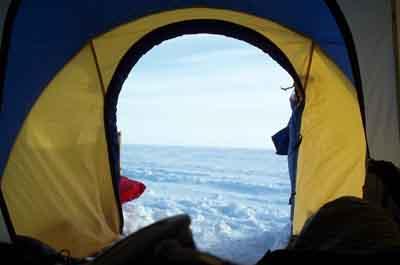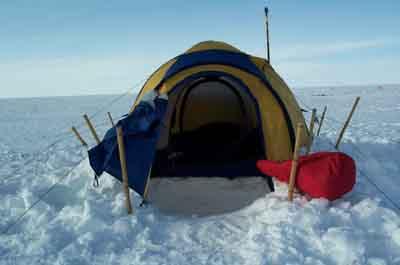3 May, 2003
Life at Camp Greenland
In short, camping on the ice sheet is an adventure.
The weather has been very pleasant. Daytime highs are around –10F with scattered clouds against a sunny sky and little wind. Night time lows are approximately –35F to –40F (who’d have guessed we’d use a freezer thermometer to measure the daytime temperature). Staying warm is a primary activity. We have found the benefits of the chemical hand warmer packs.
Our accommodations are quite nice. We each have our own individual REI 2-man mountain tent that warms up during the day due to solar radiation. This heat is lost during the night, but there are tricks to staying warm. For example, we each have 2 sleeping pads under our sleeping bag to separate us from the ice sheet. Also, when we go to bed, we fill our water bottle with boiling water to sleep with in our bag. And of course, our sleeping bags are extremely thick. It’s neat to wake up in the morning - open the door of your tent, and see nothing but a white ice sheet as far as the eye can see.
In addition to our sleep tents, there’s a common cook tent. Imagine 5 people all bundled up, with camp stoves, cooking gear, food, and an assortment of equipment… all in a 12 foot by 12 foot tent. Needless to say, the tent is “cozy.” And can get quite warm (people shed many layers coming inside). And then there’s always that one bag of dehydrated food that leaks, and everyone jumps up and does a Chinese fire drill.
As I just mentioned, the food is mostly dehydrated and dry foods. Typical breakfasts consist of granola and oatmeal with dried fruit on top. Lunches vary from instant soups to crackers and cheese to cup of noodles. Dinners are typically one large dehydrate meal of our choice and some kind of cookie for dessert. Thus far, the beef stroganoff has the most votes for tasting the best. And for the in-between times when our stomachs growl, there are plenty of powerbars and other snacks.
A common question is “How do you go to the bathroom?”
Answer, “Same way you do”
We have a dedicated tent that is 6 feet by 6 feet in size with a hole cut out of the floor. We dug a deep pit, and put the tent over that hole. It stays warm enough that exposing skin isn’t a problem, but the ventilation could use some help.
Most of our time is spent drilling cores. Everyone is working hard and the drilling is going well. Yesterday, we worked a 12 hour shift and got about 35 meters of core extracted. People are of good spirits, and the moral in the camp is high. It’s been fun to hear stories from people’s background and learn more about them.
All in all, life at Camp Greenland is good.

This is our camp. There are 7 tents. Five smaller individual tents and two larger tents. One tent isthe cook tent and the other is the 'poop' tent. The large pole is set up for hte drilling operation with a core processing area to the left.

Having a quick bite to eat in-between drilling in the cook tent. From left to right: Lou Albershardt, Sue Root, Ryan Banta and Dr. Greg Lamorey

A typical view from our area!

This picture shows the vestibule is open and we have dug a pit out so you can step into your tent. Putting boots on and off is much easier with the pit. Our tents can get very warm during the day, warm enough to dry wet, sweaty socks and boot liners. It is nice to have a little place to call home.
Contact the TEA in the field at
.
If you cannot connect through your browser, copy the
TEA's e-mail address in the "To:" line of
your favorite e-mail package.
|
